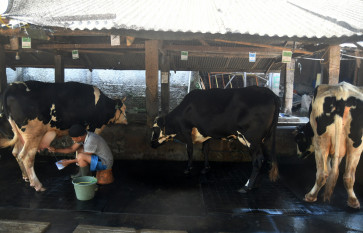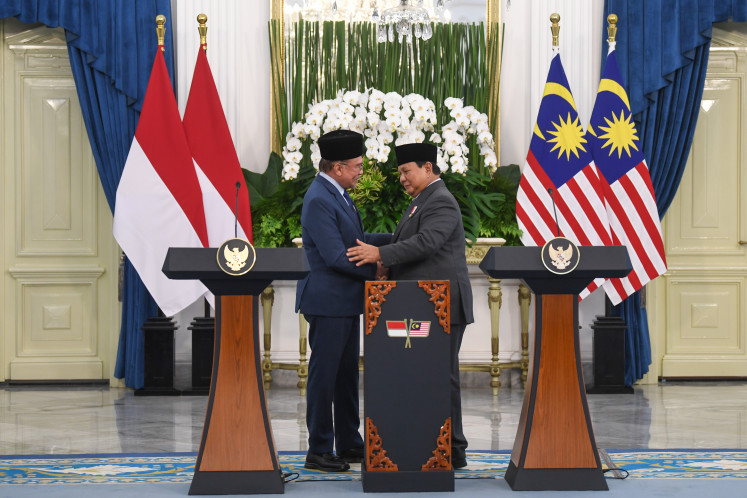Popular Reads
Top Results
Can't find what you're looking for?
View all search resultsPopular Reads
Top Results
Can't find what you're looking for?
View all search results'Nasi goreng', Merapi coffee diplomacy at Frankfurt Book Fair
Chefâs recommendation: Chef Vindex Tengker and his team prepare meals for the Publisherâs Dinner at Frankfurtâs Museum of Modern Art
Change text size
Gift Premium Articles
to Anyone
 Chefâs recommendation: Chef Vindex Tengker and his team prepare meals for the Publisherâs Dinner at Frankfurtâs Museum of Modern Art.(Courtesy of Spice It Up! Indonesia)" height="512" border="0" width="512">Chefâs recommendation: Chef Vindex Tengker and his team prepare meals for the Publisherâs Dinner at Frankfurtâs Museum of Modern Art.(Courtesy of Spice It Up! Indonesia)
Chefâs recommendation: Chef Vindex Tengker and his team prepare meals for the Publisherâs Dinner at Frankfurtâs Museum of Modern Art.(Courtesy of Spice It Up! Indonesia)" height="512" border="0" width="512">Chefâs recommendation: Chef Vindex Tengker and his team prepare meals for the Publisherâs Dinner at Frankfurtâs Museum of Modern Art.(Courtesy of Spice It Up! Indonesia)From nasi goreng (fried rice) sold from a humble gerobak (food cart) in front of Frankfurtâs historic city hall to a five-course dinner at a fancy restaurant, renowned and aspiring young chefs from Indonesia joined forces to tingle the taste buds of visitors at this yearâs Frankfurt Book Fair.
It was a chilling 4 degrees Celsius at Römerberg city hall on Tuesday evening. Chefs Ragil Wibowo and Solihin braved the cold to cook fried rice and share Indonesian street food culture with the locals.
People soon began flocking the wooden food cart, shipped in from Indonesia two months earlier, to order nasi goreng. When time was up, Ragil had sold more than 100 portions.
In the following days, they sold sate ayam (grilled chicken skewers) from another food cart.
âThey are the two most iconic Indonesian dishes. We want to promote them and eventually see [Germans] cook these at their homes,â said Ragil, who is also a cooking show host.
The street food program is part of Spice It Up! Indonesia â a collection of culinary activities around the book fair. Some
40 Indonesian culinary experts and chefs are taking part in the event, several of whom have published cooking books or foodie chronicles.
Their presence at the prestigious book fair was more than just a chance to promote their books; it was a concerted effort to encourage Europeans to include Indonesian food in their diet.
âIndonesiaâs culinary culture holds mysteries,â noted restaurateur, William Wongso. âThe tastes are unpredictable. I believe that the international market will soon take notice of our local cuisine.â
On the opening day of the fair, Oct. 13, William and his team served rice and rendang, a West Sumatran dish made of beef simmered in spices and coconut milk, klapertaart coconut-based cupcakes and some other dishes.
William admitted that some of the ingredients purchased in Germany did not meet his expectations. The Thai coconut milk, apparently, had a different flavor to the Indonesian one, and the chillies were not spicy enough. But judging from the empty plates and the number of visitors who kept coming back, the reception was a success.
William also oversees the menu at the Indonesian Canteen, located below the Indonesian Pavilion at the trade fair. It serves gado gado (vegetable salad) and chicken covered in spicy rica-rica sauce, among other things. The canteen was packed for lunch, and the dishes sold out within hours.
Among Williamâs teammates were three culinary students from a vocational school in Kudus, Central Java. The apprentices, Billa, Afifah and Yoga, also taught a cooking class for students from around Europe at the fair under the banner of Classroom of the Future program.
 Chefâs recommendation: <)
Chefâs recommendation: <)
C
span class="caption">Chef's recommendation: Chef Vindex Tengker and his team prepare meals for the Publisher's Dinner at Frankfurt's Museum of Modern Art.(Courtesy of Spice It Up! Indonesia)
From nasi goreng (fried rice) sold from a humble gerobak (food cart) in front of Frankfurt's historic city hall to a five-course dinner at a fancy restaurant, renowned and aspiring young chefs from Indonesia joined forces to tingle the taste buds of visitors at this year's Frankfurt Book Fair.
It was a chilling 4 degrees Celsius at Römerberg city hall on Tuesday evening. Chefs Ragil Wibowo and Solihin braved the cold to cook fried rice and share Indonesian street food culture with the locals.
People soon began flocking the wooden food cart, shipped in from Indonesia two months earlier, to order nasi goreng. When time was up, Ragil had sold more than 100 portions.
In the following days, they sold sate ayam (grilled chicken skewers) from another food cart.
'They are the two most iconic Indonesian dishes. We want to promote them and eventually see [Germans] cook these at their homes,' said Ragil, who is also a cooking show host.
The street food program is part of Spice It Up! Indonesia ' a collection of culinary activities around the book fair. Some
40 Indonesian culinary experts and chefs are taking part in the event, several of whom have published cooking books or foodie chronicles.
Their presence at the prestigious book fair was more than just a chance to promote their books; it was a concerted effort to encourage Europeans to include Indonesian food in their diet.
'Indonesia's culinary culture holds mysteries,' noted restaurateur, William Wongso. 'The tastes are unpredictable. I believe that the international market will soon take notice of our local cuisine.'
On the opening day of the fair, Oct. 13, William and his team served rice and rendang, a West Sumatran dish made of beef simmered in spices and coconut milk, klapertaart coconut-based cupcakes and some other dishes.
William admitted that some of the ingredients purchased in Germany did not meet his expectations. The Thai coconut milk, apparently, had a different flavor to the Indonesian one, and the chillies were not spicy enough. But judging from the empty plates and the number of visitors who kept coming back, the reception was a success.
William also oversees the menu at the Indonesian Canteen, located below the Indonesian Pavilion at the trade fair. It serves gado gado (vegetable salad) and chicken covered in spicy rica-rica sauce, among other things. The canteen was packed for lunch, and the dishes sold out within hours.
Among William's teammates were three culinary students from a vocational school in Kudus, Central Java. The apprentices, Billa, Afifah and Yoga, also taught a cooking class for students from around Europe at the fair under the banner of Classroom of the Future program.

On the first day, they assisted the students in preparing bubur Manado (mixed vegetable porridge) and kue lumpur (pumpkin soufflé pancake). On other days, they made aromatic herbal drinks, such as kunyit asam (fresh turmeric beverage) and bir pletok (a herbal drink from Jakarta).
'Cooking class is so much fun,' said 17-year-old Billa. 'The students are very curious. They ask many questions about the spices used in the cooking. At the end, they love the dishes.'
Coffee aroma filled the Indonesian Pavilion at 1 p.m., when the Indonesian Coffee Project team brewed and shared cups of rare coffee and conveyed the stories behind it.
'One of the coffees comes from Merapi, Central Java,' said Mei Batubara of the coffee project. 'Following the Mount Merapi eruption, people preferred to sell sands rather than coffee as it was more profitable.'
'We have initiated a program to empower the coffee farmers there so that we will not lose our Merapi coffee, which has a unique flavor as it is planted on volcanic soil,' she added.
Not far from the coffee tables were installations carrying a variety of exotic spices. Some visitors closely inspected Andaliman, a pepper with lime and mandarin notes cultivated in northern Sumatra, while others were curious about the yellow flakes of dried temulawak (Javanese ginger) and the red kecombrang serut (sliced ginger torch).
At a restaurant not far from the nasi goreng food cart in Römerberg chef Vindex Tengker hosted a sumptuous dinner for around 50 guests. He made salmon tartar with sambal matah (Balinese chili sauce) and Semarang-style spring rolls and pickled salad for appetizers.
'This is very fresh and tasty,' Yoza, an under-chef at nearby restaurant, said while finishing his Jakarta-style pickled salad.
Balinese spicy and sour seafood soup was followed by the main course, featuring rice with seven side dishes and condiments, including the tender flavorful lamb chop called kambing bumbu rujak and Balinese sate lilit (minced mackerel satay).
Vindex, an inflight service vice president of national flag carrier Garuda Indonesia, said that to build a market, Indonesian restaurants overseas needed to polish their presentation.
'Taste wise, our food is welcomed by foreigners. However, some restaurants have not succeeded in packaging their service. As a result, they tend to look like a canteen rather than a restaurant,' he said.
Culinary presenter and writer Bondan Winarno, renowned chef Sisca Soewitomo and chef Bara Pattiradjawane also shared recipes in a series of cooking sessions at the fair.









